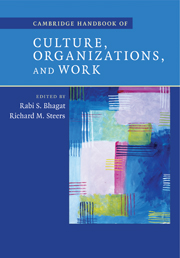Book contents
- Frontmatter
- Contents
- List of figures
- List of tables
- List of contributors
- Preface
- PART I CULTURAL FOUNDATIONS
- 1 The culture theory jungle: divergence and convergence in models of national culture
- 2 Culture, organizations, and institutions: an integrative review
- 3 When does culture matter?
- PART II CULTURE AND ORGANIZATION THEORY
- PART III CULTURE AND ORGANIZATIONAL BEHAVIOR
- PART IV FUTURE DIRECTIONS IN THEORY AND RESEARCH
- Index
1 - The culture theory jungle: divergence and convergence in models of national culture
Published online by Cambridge University Press: 15 December 2009
- Frontmatter
- Contents
- List of figures
- List of tables
- List of contributors
- Preface
- PART I CULTURAL FOUNDATIONS
- 1 The culture theory jungle: divergence and convergence in models of national culture
- 2 Culture, organizations, and institutions: an integrative review
- 3 When does culture matter?
- PART II CULTURE AND ORGANIZATION THEORY
- PART III CULTURE AND ORGANIZATIONAL BEHAVIOR
- PART IV FUTURE DIRECTIONS IN THEORY AND RESEARCH
- Index
Summary
On both a conceptual and empirical level, serious research on cultural differences in organization and management has been simultaneously facilitated and inhibited by the existence of multiple and often conflicting models of national culture. These models offer useful templates for comparing management processes, HRM policies, and business strategies across national borders. Some models have gone a step further and offered measures or numerical indicators for various countries that have been used widely in cross-cultural research. However, a problem that continues to plague organizational researchers in this area is a lack of convergence across these models. This divergence represents what we refer to as the culture theory jungle – a situation in which researchers must choose between competing, if sometimes overlapping, models to further their research goals and then defend such choices against a growing body of critics. This reality fails to facilitate either parsimony or rigor in organizational research, let alone useful comparisons across studies and samples.
As such, after a brief review of the divergence that currently exists in the most commonly used models of culture, we argue in this paper that a clear need exists to seek convergence across the various models where it exists in ways that facilitate both research and meaningful cross-cultural comparisons. We then seek such convergence by identifying five relative common themes, or core cultural dimensions, that pervade the various extant models. Based on these themes, culture ratings for country clusters are presented based on data secured through the use of multiple measures and multiple methods.
- Type
- Chapter
- Information
- Publisher: Cambridge University PressPrint publication year: 2009
- 61
- Cited by



